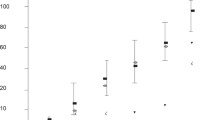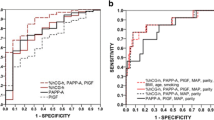Abstract
Objective
The human placenta is a neuroendocrine organ that produces several hypothalanmic and pituitary hormones that are secreted during pregnancy and parturition into maternal and fetal circulation and amniotic fluid. Human chromogranin A (CgA) is a glycoprotein mainly localized to the adrenal medulla and released in response to several stressful events. During pregnancy, intrauterine tissues express and synthesize CgA mRNA and peptide and secret it into the biologic fluids of pregnancy, so we investigated whether maternal, umbilical, and amniotic human CgA levels are affected by the stress of parturition.
Methods
We measured pregnancy CgA levels in maternal and umbilical cord plasma and in amniotic fluid at term (39–40 weeks), by enzyme-linked immunosorbent assay at elective cesarean (n = 16), after spontaneous vaginal delivery (n = 12), and longitudinally throughout labor and 2 hours postpartum.
Results
CgA levels were highest in umbilical cord blood (P < .001). Umbilical cord plasma and amniotic fluid CgA levels were significantly higher at spontaneous vaginal delivery than at cesarean (P < .001), and the levels were not changed in maternal plasma according to cervical dilatation and postpartum.
Conclusions
The present findings showed that the stress of parturition increased CgA levels in umbilical cord plasma and amniotic fluid and was probably of fetal origin. Whatever the mode of delivery, CgA levels in infants were much more elevated than in mothers, providing evidence for an unusual and sustained high level of sympathoadrenal stimulation in full-term neonates.
Similar content being viewed by others
References
Huttner WB, Benedum UM. Chromogranin A and pancreasta-tin. Nature 1987;325:305.
Lloyd RV, Cano M, Rosa P, Hille A, Huttner WB. Distribution of chromogranin A and secretogranin I (chromogranin B) in neuroendocrine cells and tumors. Am J Pathol 1988;130:296–304.
Lloyd RV, Wilson BS. Specific endocrine tissue marker defined by a monoclonal antibody. Science 1983;222:628–30.
Takiyyuddin MA, Cervenka JH, Pandian MR, Stuenkel CA, Heumann HPH, O’Connor DT. Neuroendocrine sources of chromogranin A in normal man: Clues from selective stimulation of endocrine glands. J Clin Endocrinol Metab 1990;71:360–9.
O’Connor DT, Burton D, Deftos LJ. Immunoreactive human chromogranin A in diverse polypeptide hormone producing tumors and normal endocrine tissues. J Clin Endocrinol Metab 1983;57:1084–6.
Simon JP, Bader MF, Aunis D. Proteolytic processing of chromogranin A in cultured chromaffin cells. Biochimic Biophys Acta 1989;1051:123–30.
O’Connor DT, Frigon RP. Chromogranin A, the major catecholamine storage vesicle soluble protein. J Biol Chem 1984;259:3237–47.
Syversen U, Opsjon SL, Stridsberg M, et al. Chromogranin A and pancreastatin-like immunoreactivity in normal pregnancy. J Clin Endocrinol Metab 1996;81:4470–5.
Moftaquir-Handaj A, Barbè F, Barbarino-Monnier P, Aunis D, Boutroy MJ. Circulating Chromogranin A and catecholamines in human fetuses at uneventful birth. Pediatr Res 1995;37:101–5.
Petraglia F, Volpe A, Genazzani AR, Rivier J, Sawchenko PE, Vale W. Neuroendocrinology of the human placenta. Frontiers Neuroendocrinol 1990;11:6–37.
Petraglia F, Florio P, Nappi C, Genazzani AR. Peptide signaling in human placenta and membranes: Autocrine, paracrine, and endocrine mechanisms. Endocr Rev 1996;17:156–86.
Wang L, Zhang W, Zhao Y. The study of maternal and fetal plasma catecholamines levels during pregnancy and delivery. J Perinat Med 1999;27:195–8.
Holst N, Jenssen TG, Burhol PG, Jorde R, Maltau JM. Plasma vasoactive intestinal polypeptide, insulin, gastric inhibitory poypeptide, and blood glucose in late pregnancy and during and after delivery. Am J Obstet Gynecol 1986;155:126–31.
Petraglia F, Calzà L, Giardino L, et al. Identification of immunoreactive neuropeptide Y in human placenta: Localization, secretion, and binding sites. Endocrinology 1989;124:2016–22.
Petraglia F, Coukos G, Battaglia C, et al. Plasma and amniotic fluid immunoreactive neuropeptide-Y level changes during pregnancy, labor and parturition. J Clin Endocrinol Metab 1989;69:324–8.
Reis FM, Fadalti M, Florio P, Petraglia F. Putative role of placental corticotropin-releasing factor in the mechanisms of human parturition. J Soc Gynecol Investig 1999;6:109–19.
Challis JRG, Matthews SG, Gibb W, Lye SW. Endocrine and paracrine regulation of birth at term and preterm. Endocr Rev 2000;21:514–50.
Winkler H, Fischer-Colbrie R. The chromogranin A and B: The first 25 years and future prospectives. Neuroscience 1992;49:497–528.
Molenaar WN, Lee VMY, Trojanowskija JQ. Early fetal acquisition of the chromaffin and neural immunophenotype by human adrenal medullary cells: An immunohistochemical study using monoclonal antibodies to chromogranin A, synaptophysin, tyrosine hydroxylase and neural cytoskeletal protein. Exp Neurol 1990;108:1–9.
Herman LJ, Ahn TG, Levine MA, et al. Molecular cloning and primary structure of human chromogranin A (secretory protein I) cDNA. J Biol Chem 1988;263:11559–63.
Schober M, Fisher-Colbrie R, Winkler H. Ontogenesis of chromogranin A and B and catecholamines in rat adrenal medulla. Brain Res 1989;478:41–6.
Padbury JF, Martinez AM. Sympatho adrenal system activity at birth: Integration of postnatal adaptation. Semin Perinatol 1988;12:163–72.
Slotkin TA, Seidler FJ. Adrenomedullary catecholamine release in the fetus and the newborn: Secretory mechanism and their role in stress and survival. J Dev Physiol 1988;10:1–16.
Lundberg JM, Hemsen A, Fried G, Theodorsson-Norheim E, Lagercrantz H. Corelease of neuropeptide Y (NPY)-like immunoreactivity and catecholamines in newborn infants. Acta Physiol Scand 1986;126:471–3.
Simon JP, Bader MF, Aunis D. Secretion from chromaffin cells is controlled by chromogranin A-derived peptides. Proc Natl Acad Sci USA 1988;85:1712–6.
Galindo E, Rill A, Bader MF, Aunis D. Chromostatin, a 20-amino acid peptide derived from chromogranin A, inhibits chromaffin cell secretion. Proc Natl Acad Sci USA 1991;88:1426–0.
Wand GS, Takiyyuddin M, O’Connor DT, Levine MA. A proposed role for chromogranin A as a glucocorticoid-responsive autocrine inhibitor of poopiomelanocortin secretion. Endocrinology 1991;128:13450–1.
Aardal S, Galindo E, Aunis D, Helle KB. Human chromostatin inhibits endothelin-1-induced contractures in human blood vessels. Regulatory Peptides 1993;47:25–32.
Hsiao RJ, Mezger MS, O’Connor DT. Chromogranin A in uremia: Progressive retention of immunoreactive fragments. Kidney Int 1990;37:955–64.
Author information
Authors and Affiliations
Corresponding author
Rights and permissions
About this article
Cite this article
Florio, P., Mezzesimi, A., Turchetti, V. et al. High Levels of Human Chromogranin A in Umbilical Cord Plasma and Amniotic Fluid at Parturition. Reprod. Sci. 9, 32–36 (2002). https://doi.org/10.1177/107155760200900107
Published:
Issue Date:
DOI: https://doi.org/10.1177/107155760200900107




